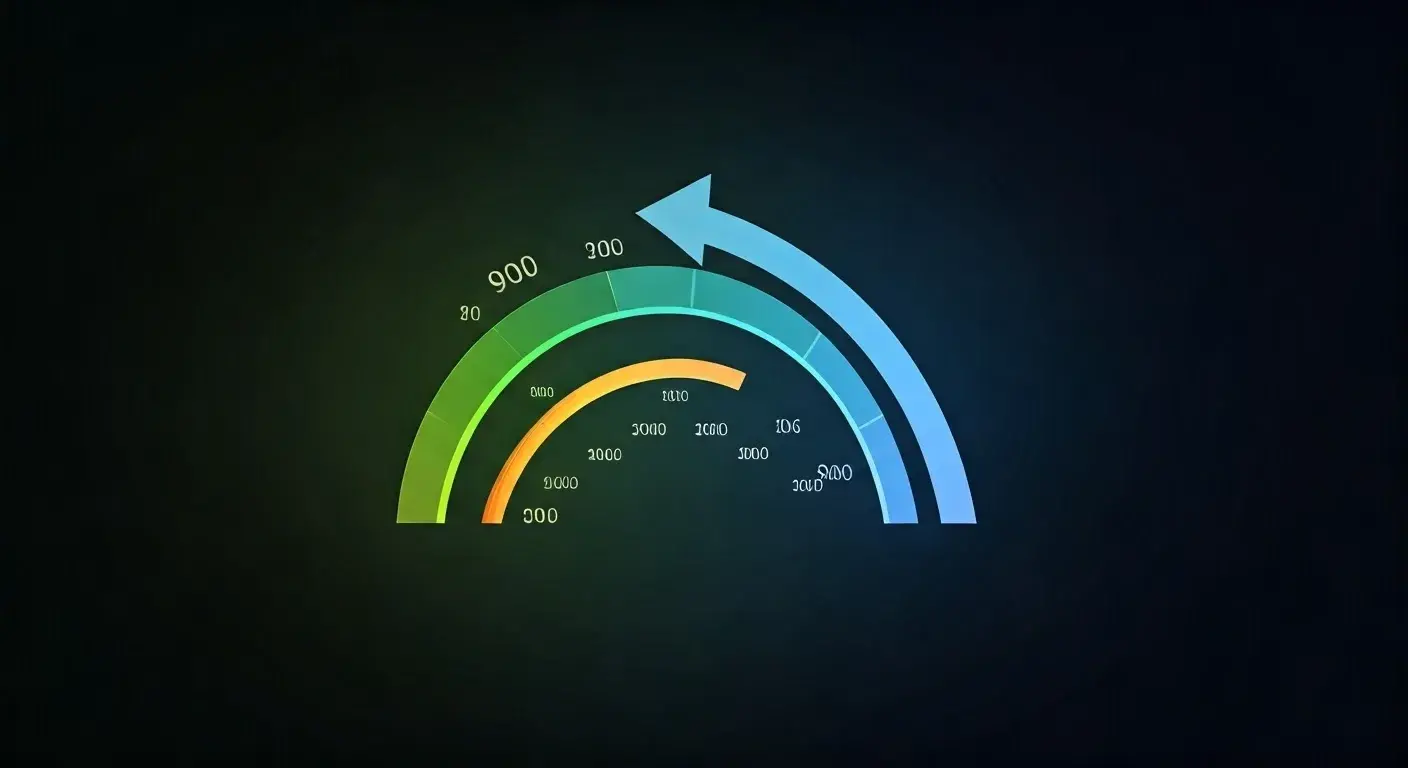-
Posted on: 24 Dec 2022

-
Achieving a 100-point credit score increase in just 30 days is an ambitious goal, but with a strategic and focused approach, it's attainable. This guide provides actionable steps and expert insights to help you navigate the credit landscape and significantly improve your score within this tight timeframe.
Understanding Your Credit Score: The Foundation
Before embarking on a rapid credit score improvement journey, it's crucial to understand what a credit score is and how it's calculated. Your credit score is a three-digit number that lenders use to assess your creditworthiness. It's a snapshot of your financial behavior, indicating how likely you are to repay borrowed money. In 2025, the most widely used credit scoring models are FICO and VantageScore, both of which consider similar factors, though their exact weighting may differ slightly.
Key Factors Influencing Your Credit Score
Understanding these factors is the first step to manipulating them for your benefit:
- Payment History (35% for FICO): This is the most critical component. It reflects whether you pay your bills on time. Late payments, defaults, and bankruptcies can severely damage your score.
- Amounts Owed (30% for FICO): This refers to your credit utilization ratio – the amount of credit you're using compared to your total available credit. Keeping this low is paramount.
- Length of Credit History (15% for FICO): The longer you've had credit accounts open and in good standing, the better. This demonstrates a track record of responsible credit management.
- Credit Mix (10% for FICO): Having a mix of different credit types (e.g., credit cards, installment loans) can be beneficial, but it's less impactful than payment history and utilization.
- New Credit (10% for FICO): Opening multiple new credit accounts in a short period can negatively affect your score, as it suggests increased risk.
Why a 100-Point Jump in 30 Days is Ambitious
It's important to set realistic expectations. A 100-point increase in 30 days is a significant leap, especially if your score is already in the excellent range. For individuals with lower scores (e.g., below 600), a 100-point jump might be more achievable, as there's more room for improvement. However, for those with scores above 700, such a rapid increase is exceptionally difficult. The key is to focus on the factors that have the most immediate impact, primarily payment history and credit utilization.
The 30-Day Credit Score Boost Blueprint
This blueprint is designed for maximum impact within a short timeframe. It prioritizes actions that can influence your score quickly. Remember, consistency is key, and while 30 days is our target, some actions might yield results sooner than others.
Step 1: Get Your Credit Reports
You can't improve what you don't understand. Obtain your credit reports from all three major bureaus: Equifax, Experian, and TransUnion. You are entitled to a free report from each bureau annually via AnnualCreditReport.com. This is crucial for identifying errors and understanding your current standing.
Actionable Task:
Immediately request your reports. Review them meticulously for any inaccuracies, such as incorrect personal information, accounts you don't recognize, or incorrect payment statuses.
Step 2: Dispute Errors Aggressively
If you find any errors, dispute them immediately with the credit bureaus and the creditor. The bureaus have 30 days to investigate, which perfectly aligns with our 30-day goal. A corrected report can lead to an instant score increase.
Actionable Task:
File disputes online through the credit bureaus' websites. Provide all supporting documentation. Keep meticulous records of all communication.
Step 3: Address Payment History Immediately
Since payment history is the most significant factor, ensuring all your payments are on time is non-negotiable. For the next 30 days, every single bill must be paid by its due date, or ideally, a few days before.
Actionable Task:
Set up automatic payments for all your credit accounts and bills. If you have any past-due accounts, pay them immediately. Even a single late payment can undo significant progress.
Step 4: Master Credit Utilization
This is where you can often see the most dramatic short-term gains. Your credit utilization ratio (CUR) is the amount of revolving credit you're using divided by your total revolving credit limit. Lenders prefer this ratio to be below 30%, but for rapid improvement, aiming for below 10% is ideal.
Actionable Task:
Pay down your credit card balances as much as possible. Focus on cards with the highest utilization first. If you can't pay them off entirely, make substantial payments before the statement closing date.
Step 5: Consider a Credit Limit Increase (with caution)
If you have a good payment history with a particular card issuer, you might be able to request a credit limit increase. This can instantly lower your utilization ratio, provided you don't increase your spending. However, be aware that some issuers perform a "hard pull" on your credit, which can temporarily lower your score. A "soft pull" is preferable.
Actionable Task:
Contact your credit card issuers to inquire about a credit limit increase. Ask if it will result in a hard inquiry. If it's a hard inquiry, weigh the potential benefit against the temporary dip.
Step 6: Become an Authorized User (Strategic Use Only)
If you have a trusted friend or family member with excellent credit, ask them to add you as an authorized user on one of their older, well-managed credit cards. Their positive payment history and low utilization on that account can then appear on your credit report, potentially boosting your score. However, ensure the primary cardholder is responsible, as their negative actions could also impact you.
Actionable Task:
Discuss this option with a trusted individual. Ensure they understand the implications and are willing to maintain responsible credit habits.
Payment History: The Kingmaker of Your Score
As mentioned, payment history is the most influential factor in your credit score, accounting for approximately 35% of your FICO score. This means that every single payment you make, or fail to make, has a significant ripple effect. For a 30-day sprint, ensuring perfect on-time payments is paramount. This isn't just about the next 30 days; it's about establishing a habit that will serve you long-term.
The Impact of Late Payments
A single 30-day late payment can drop your score by as much as 100 points, especially if your score is already high. Longer delinquencies (60, 90 days, or more) have an even more devastating effect. In 2025, the credit scoring models are sophisticated enough to detect even minor lapses in payment timeliness. Therefore, avoiding any new late payments is the absolute priority.
Actionable Steps for Perfect Payments:
- Automate Everything: Set up automatic payments for all your credit cards, loans, and other bills. Ensure you have sufficient funds in your bank account to cover these payments.
- Calendar Reminders: Supplement automatic payments with calendar reminders a few days before the due date. This provides a backup in case of technical glitches or insufficient funds.
- Prioritize Payments: If you're facing a cash crunch, prioritize your credit card payments. These have the most significant impact on your score due to their revolving nature and utilization factor.
- Contact Lenders Proactively: If you anticipate a payment difficulty, contact your lender *before* the due date. They may be willing to offer a grace period or a temporary payment arrangement, which is far better than a reported late payment.
Dealing with Past Due Accounts
If you have accounts that are currently past due, your immediate focus should be on bringing them current. The longer an account remains delinquent, the more it harms your score. Once an account is brought current, it will still show as having been late, but the negative impact will lessen over time compared to a continuously delinquent account.
Actionable Steps:
- Pay Immediately: If an account is 30, 60, or 90 days late, pay the minimum amount due to bring it current as soon as possible.
- Negotiate with Creditors: For severely delinquent accounts, you might be able to negotiate a payment plan or even a settlement. While a settlement might not remove the delinquency mark entirely, it stops further negative reporting and can be a step towards recovery.
Credit Utilization: Your Secret Weapon
Credit utilization is the second most significant factor influencing your credit score, typically accounting for around 30% of your FICO score. This is where you can often see the most rapid positive changes. The goal is to reduce the amount of credit you're using relative to your total available credit.
Understanding the Ratio
The credit utilization ratio (CUR) is calculated by dividing the total balance on your revolving credit accounts (like credit cards) by your total credit limit. For example, if you have a credit card with a $10,000 limit and a $5,000 balance, your utilization on that card is 50%.
Formula:
Credit Utilization Ratio = (Total Balances on Revolving Credit / Total Credit Limits) * 100Strategies for Rapid Reduction
To achieve a 100-point increase in 30 days, aggressively lowering your CUR is essential. Ideally, you want to get this ratio below 10% across all your cards and ideally below 30% on each individual card.
1. Pay Down Balances Aggressively:
This is the most direct way to lower your utilization. Focus your efforts on paying down credit card debt. If you have multiple cards, prioritize those with the highest utilization ratios first. Paying down balances before the statement closing date is crucial because that's the balance that gets reported to the credit bureaus.
Example:
Suppose you have two credit cards:
- Card A: $5,000 limit, $4,000 balance (80% utilization)
- Card B: $2,000 limit, $1,000 balance (50% utilization)
Total balance: $5,000. Total credit limit: $7,000.
Overall utilization: ($5,000 / $7,000) * 100 = 71.4%
If you pay down Card A by $3,000:
- Card A: $5,000 limit, $1,000 balance (20% utilization)
- Card B: $2,000 limit, $1,000 balance (50% utilization)
New total balance: $2,000. Total credit limit: $7,000.
New overall utilization: ($2,000 / $7,000) * 100 = 28.6%
This significant reduction in utilization can lead to a substantial score increase.
2. Strategic Balance Transfers (Use with Extreme Caution):
A balance transfer to a 0% introductory APR card can help you pay down debt faster without accruing interest. However, this doesn't directly lower your reported utilization for the current billing cycle unless you pay off the original card. The key is to ensure the balance transfer doesn't come with a high fee that negates the savings, and that you have a solid plan to pay off the balance before the introductory period ends.
3. Requesting Credit Limit Increases:
As mentioned earlier, requesting a credit limit increase on existing cards can lower your utilization ratio if your balance remains the same. For instance, if you have a $5,000 balance on a $10,000 limit card (50% utilization), and you get the limit increased to $15,000, your utilization drops to 33.3% ($5,000 / $15,000).
Considerations:
- Hard vs. Soft Inquiry: Always inquire if the request will result in a hard inquiry. A hard inquiry can temporarily lower your score by a few points.
- Responsible Use: A higher credit limit should not be an invitation to spend more. Stick to your budget.
4. Spreading Balances Across Cards:
If you have multiple cards with high balances, consider paying down one card completely and then shifting focus to another. Closing accounts can sometimes hurt your score by reducing your overall available credit, so it's often better to keep accounts open and manage their balances.
The Power of "Garbage In, Garbage Out" for Utilization
Credit card companies report your balance to the credit bureaus typically once a month, usually on your statement closing date. To maximize the impact of your payments within the 30-day window, make significant payments *before* your statement closing dates. This ensures that the lower balance is reported to the credit bureaus, which can then be reflected in your credit score.
Credit Mix and Age: Long-Term Strategies (and how they impact short-term goals)
While payment history and credit utilization are the primary drivers for rapid score improvement, credit mix and length of credit history also play roles. Understanding these can help you avoid actions that might hinder your 30-day goal and set you up for continued success.
Credit Mix (10% of FICO Score)
This factor considers the variety of credit accounts you have, such as credit cards (revolving credit) and installment loans (mortgages, auto loans, personal loans). Having a healthy mix can demonstrate your ability to manage different types of credit responsibly. However, its impact is relatively small, and it's generally not advisable to open new accounts solely to improve your credit mix, especially within a tight 30-day timeframe.
Impact on 30-Day Goal:
For a 30-day goal, actively changing your credit mix is unlikely to yield significant results. If you currently only have credit cards, opening an installment loan just for the sake of mix is not a priority. Focus on perfecting your existing accounts. If you happen to have a mix already, ensure all accounts are in good standing.
Length of Credit History (15% of FICO Score)
This factor looks at how long your credit accounts have been open and the average age of your accounts. A longer credit history generally indicates more experience managing credit, which is viewed favorably. The average age of your accounts is calculated by averaging the age of all your open accounts.
Impact on 30-Day Goal:
You cannot significantly alter the length of your credit history in 30 days. The most important thing here is to avoid closing older, established accounts. Closing an old account can reduce your average account age and decrease your overall available credit, potentially hurting your utilization ratio. Therefore, for the next 30 days, keep all your existing accounts open, even if you don't use them frequently.
New Credit (10% of FICO Score)
Opening new credit accounts can temporarily lower your score. Each application for credit typically results in a "hard inquiry" on your credit report, which can deduct a few points. Multiple inquiries in a short period signal higher risk to lenders. Therefore, for your 30-day push, it's best to avoid applying for any new credit unless it's absolutely essential or strategically planned (like a credit limit increase that doesn't involve a hard pull).
Actionable Steps for the Next 30 Days:
- Do Not Close Old Accounts: Resist the temptation to close any credit card accounts, especially those that are old and have a good history.
- Avoid New Applications: Unless it's a credit limit increase request with a soft pull, refrain from applying for new credit cards or loans.
- Focus on Existing Accounts: Direct all your energy towards managing your existing credit cards and loans impeccably.
Dealing with Negative Marks: Damage Control
Negative marks on your credit report, such as late payments, collections, charge-offs, bankruptcies, or judgments, can significantly lower your score. While removing them entirely in 30 days is often impossible, you can take steps to mitigate their impact and prevent new ones from appearing.
Understanding Negative Mark Types and Durations
Different negative marks have varying impacts and durations on your credit report:
- Late Payments: Remain for 7 years, with the most recent ones having the biggest impact.
- Collections: Can remain for 7 years from the date of delinquency.
- Charge-offs: Remain for 7 years from the date of delinquency.
- Bankruptcies: Chapter 7 can remain for 10 years; Chapter 13 for 7 years.
- Judgments: Can remain for 7-10 years or longer, depending on the state.
Strategies for Mitigation within 30 Days
1. Dispute Errors on Negative Marks:
Even negative marks can contain errors. If you find any inaccuracies regarding a late payment, collection, or other negative item, dispute it immediately. If the credit bureau or creditor cannot verify the information within their investigation period (typically 30 days), the item must be removed.
2. The "Pay for Delete" Strategy (Not Guaranteed):
This involves negotiating with a collection agency to remove a negative mark from your credit report in exchange for payment. While effective if successful, collection agencies are not obligated to agree to this. It's more likely to work with newer collections.
Actionable Steps:
- Contact the collection agency.
- Offer to pay the debt in full or settle for a lesser amount.
- Crucially, get the agreement in writing *before* making any payment. The agreement should explicitly state that the collection account will be removed from your credit report upon payment.
3. Bringing Accounts Current:
If you have accounts that are currently delinquent (30, 60, 90 days late), bringing them current is the absolute priority. While the past lateness will remain on your report for a period, stopping the ongoing delinquency prevents further damage and shows creditors you are taking steps to improve.
4. Managing Existing Collections:
If you have outstanding collections, consider addressing them. Paying off a collection account will update its status to "paid," which is better than "unpaid." However, the collection itself will likely remain on your report for its duration. The "pay for delete" is the only way to remove it entirely.
5. Avoiding New Negative Marks:
This goes back to the payment history section. For the next 30 days, every single payment must be made on time. This is the most effective way to prevent new negative marks from appearing and derailing your progress.
Credit Monitoring Services
Consider using a credit monitoring service. Many offer free trials and can alert you to changes on your credit report, including new inquiries, new accounts, and significant score fluctuations. This can help you stay proactive and catch any potential issues early.
Monitoring Your Progress: Staying on Track
Consistent monitoring is crucial to understand the impact of your actions and to stay motivated. Without tracking, you might be making efforts that aren't yielding the desired results or might miss opportunities for improvement.
How Often Should You Check Your Score?
For a 30-day intensive improvement plan, checking your credit score weekly is advisable. Many credit card issuers and financial apps offer free credit score monitoring. These are typically FICO or VantageScore scores, which are good indicators of your progress. Remember that these scores may differ slightly from the ones lenders pull.
Understanding Score Changes
As you implement the strategies outlined, you should start to see your score increase. The most significant jumps are often seen after:
- Disputing and removing errors.
- Substantially lowering credit card balances, especially before statement closing dates.
- Having a positive payment history reported for the first time after a period of lateness.
It's important to note that credit scoring models are complex. Sometimes, a score might not change immediately after a payment or balance reduction. This is because the credit bureaus update information at different times, and the scoring models weigh multiple factors simultaneously.
Tools for Monitoring
- Credit Card Issuer Apps/Websites: Many major credit card companies provide free access to your credit score and report details.
- Free Credit Monitoring Services: Websites like Credit Karma, Credit Sesame, and Experian offer free credit scores and reports, though they may use VantageScore and have slightly different reporting frequencies than FICO.
- AnnualCreditReport.com: While you get free reports annually, you can purchase additional reports if needed, but for monitoring, the services above are more practical.
Actionable Task:
Set a reminder to check your credit score every Monday morning for the next four weeks. Note down any changes and try to correlate them with the actions you've taken during the previous week. This will help you identify what's working best for your specific credit profile.
What to Do if Your Score Isn't Moving
If, after two weeks of diligent effort, you're not seeing the expected movement, revisit your strategy:
- Review Utilization: Are your balances truly low relative to your limits? Did you pay down balances *before* the statement closing date?
- Check for New Negative Marks: Ensure no new late payments or other negative events have occurred.
- Dispute Errors Again: Double-check your credit reports for any overlooked errors.
- Consider Authorized User Strategy: If feasible and safe, explore becoming an authorized user.
Realistic Expectations and Next Steps
Achieving a 100-point credit score increase in 30 days is an aggressive target. While this guide provides the most effective strategies for rapid improvement, the actual outcome depends on your starting credit profile, the specific actions you take, and the reporting cycles of the credit bureaus and your creditors.
Recap of Key Strategies for a 100-Point Jump
- Perfect Payment History: Make every single payment on time.
- Drastically Reduce Credit Utilization: Aim for below 10% on all revolving accounts. Pay down balances before statement closing dates.
- Dispute All Errors: Meticulously review reports and dispute any inaccuracies.
- Strategic Authorized User: Leverage a trusted individual's good credit.
- Avoid New Credit Applications: Do not open new accounts during this period.
When is a 100-Point Jump Realistic?
A 100-point increase in 30 days is more achievable for individuals with lower credit scores (e.g., below 600) who have significant room for improvement. For those with scores already in the fair to good range (600-700), a 50-70 point increase might be more typical. If your score is already in the very good to excellent range (700+), a 100-point jump in such a short period is highly improbable.
What to Do After 30 Days
Regardless of whether you hit the 100-point mark, the habits you've cultivated over the past 30 days are invaluable for long-term credit health. Continue to:
- Pay Bills on Time: This is the bedrock of good credit.
- Keep Utilization Low: Maintain balances below 30%, ideally below 10%.
- Monitor Your Credit: Regularly check your scores and reports for changes and errors.
- Build a Positive Credit History: Continue responsible credit management over months and years.
Long-Term Credit Health
Building and maintaining excellent credit is a marathon, not a sprint. While this 30-day plan focuses on rapid acceleration, sustained good practices are what build a truly robust credit score. Focus on consistency, financial discipline, and smart credit management to achieve your financial goals, whether it's buying a home, purchasing a car, or securing favorable loan terms in the future.
By diligently applying the strategies outlined in this guide, you can make significant strides in improving your credit score within 30 days. Remember that patience and persistence are key, and even if the exact target isn't met, the positive habits formed will serve you well for years to come.











